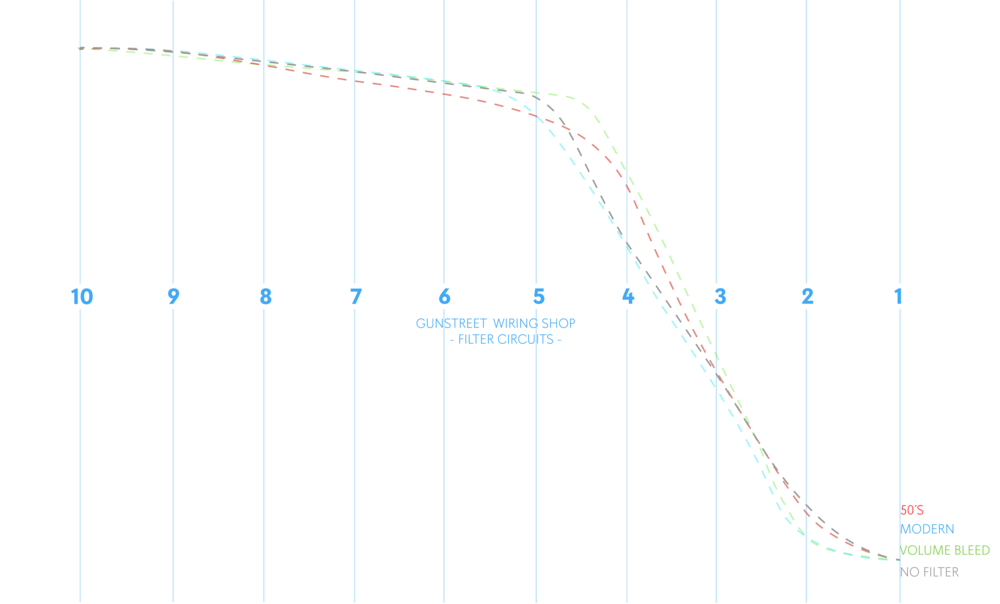WHAT THE HECK IS THE DIFFERENCE?
by Sean Arbow
Continuing our theme of educating people into making informed decisions when it comes to the "wiring" in your instrument, we are going to expand on the differences between these circuits and which one works for you. Now before we start, we want to express a few things. First, we are trying to oversimplify a complex topic so bear with us. Secondly, despite what that person in your social group using all capitals says, one circuit isn’t better than another. Each circuit affects the signal differently and it comes down to your playing style to say which one is better for you. Lastly, at 10 or 0 these all sound the same. The real difference is how it works between 9-1. I’m sorry to say this but putting a 50s kit in your instrument and leaving it at 10 the whole time won't make it “Sound Vintage” …..I know, I know. This sounds wrong. but it's true. This is a sales tactic you see people who sell mojo use to sell kits when they don’t understand how these work. Alright, now that we got that off our chest LET'S start!
IN THIS ARTICLE, WE WILL USE TERMS THAT MAY SOUND CONFUSING. IF YOU DON’T KNOW WHAT THEY MEAN, WE ARE GOING TO START BY DEFINING THESE TERMS.
AUDIBLE TAPER: Not to be confused with a brands taper which doesn’t affect the filter circuit as much as people think it does. The audible taper in this sense is defined by how the volume or tone rolls off or drops. Using volume as an example if we say something such as this one has a steep taper what we are saying is the volume level drops quicker then what you would expect.
FILTER CIRCUIT: High or low pass filters. This one is somewhat easy to remember as it is in the name. A high pass filter saves the high frequencies, and the low pass filter saves the lows. Easy enough, right? Now for what you came here for, the meat and potatoes.

CHOOSING A FILTER CIRCUIT
Now, as we said before, whatever one you choose, is defined by what you want to hear from it and how you use your instrument. Again, if you are someone who doesn’t even touch your controls then i might call you a weirdo but i am only joking. Lol. If that is the case then any of these works just fine. So, the first thing you have to decide is what filter is more important to you. Do you prefer your instrument having more highs at lower volumes, or do you like more lows? If you say "lows", then congratulations you can stop reading this. You chose “modern” if you prefer more highs. Let’s keep going.
HIGH PASS FILTERS: Welcome lovers of the highs. Let's continue. So both 50's and Treble bleed are high pass filters. As we said before, they save the highs as you decrease the volumes. But how they do it is completely different than the other. Let’s start with the og and talk about the “50's”. Whenever someone uses the term “it sounds vintage”, what they are most likely referring to is how the audible taper acts. The taper for both the volume and tone act completely different than what most people are familiar with. The taper example used above is in reference to this circuit. The volume has a very steep audible taper. The volume level drop reminds me of the signal falling down a steep hill. The tone taper is like a cliff. Super subtle changes from 9-1.5 and then 1.5-to 0 it engages. Volume bleed, on the other hand, has a more modern taper for both the volume and tone. It works in the way most people are familiar with, 9 sounds like 9, 7 sounds like 7, etc. So which one works for you? The way i would look at it, is how much do you use your volume and tone controls. Are you someone who only uses your volume and keeps the tone a 10 or 1, or are you someone who uses every level on each control? This means that you like to dial back the tone to say, 5. If you are someone who is like the first example and only uses the volume and the tone at 10 , then 50's is a great circuit for you. If you are the other example, i would do the Treble bleed circuit.
ARE YOU AIMING FOR A SMOOTHER TAPER?
A lot of times i will get people asking for another guitars style of taper because they hate their current set up. “My Strat has a terrible taper and this Les Paul i have has a smooth one. Can I use the same filter circuit in my Strat?” Where from the outside that seems like a legit simple question, where it gets complex is in 2 Areas.
-
EQ of the Pickups: Using the Strat/LP reference. Both instruments use low pass filters, but because the eq of the Strat’s pickups are in the "high end range" the low pass filter will sound more aggressive then the Les Paul's humbuckers that are more low end based. So if you are someone trying to get a smoother audible taper i would first highly suggest using a filter circuit that matches the eq of the pickups.
-
Pot Manufactures Taper: This is important when either “fine tuning your personal ear” or copying an “Instruments sound branding” but look at the Pot Manufactures taper. Not to be confused with a circuit’s “Audible Taper,” engineers will either use an Audio, or Linear in either the Volume or tone positions to get their desired sound goal. So, if you want a similar functionality. Look at what they used in those situations. One brand might be all audio, another is Linear in the Volume and Audio in the Tone, or lastly, Audio in the Volume, and Linear in the tone. Just remember there’s no “wrong way’ of using Audio or Linear, just personal preferences
About the Author: Sean Arbow
Sean has been obsessed with circuit designing for 18+ years, He was our custom shop builder and has made tens of thousands of kits for people, including some very high-profile musicians. He's the style of nerd your favorite local tech fanboys about
